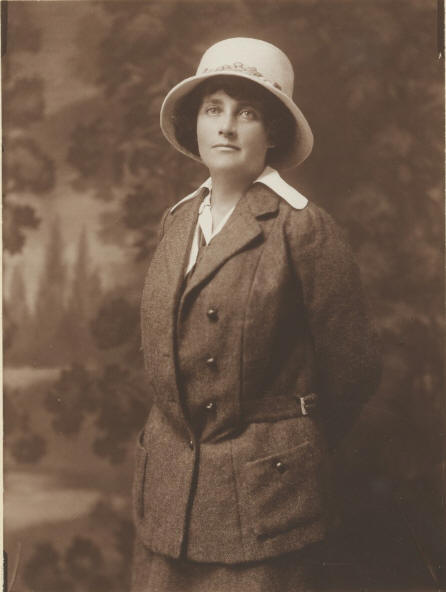

Partner Anna Snyder Van Vechten
Queer Places:
129 E 10th St, New York, NY 10003
8 E 8th St, New York, NY 10003
 Paula
Oberndorf Jakobi (1870 – July 12, 1960) was a member of the
Heterodoxy Club
and for 14 years the lover of Anna Snyder Van Vechten.
Jakobi was a suffrage leader in New York City, affiliated with the National
Woman's Party. She organized an event at Cooper Union in 1914, where Lincoln
Steffens, Zona Gale,
Edna Ferber and
many other pro-suffrage authors gave readings and sold autographed books for
the cause.[2][3]
Jakobi studied prison reform at the Massachusetts women's reformatory in
Framingham, and wrote with urgency the lives of destitute women.[4]
She was also, for three years, the opera critic for a New York newspaper.[5]
Paula
Oberndorf Jakobi (1870 – July 12, 1960) was a member of the
Heterodoxy Club
and for 14 years the lover of Anna Snyder Van Vechten.
Jakobi was a suffrage leader in New York City, affiliated with the National
Woman's Party. She organized an event at Cooper Union in 1914, where Lincoln
Steffens, Zona Gale,
Edna Ferber and
many other pro-suffrage authors gave readings and sold autographed books for
the cause.[2][3]
Jakobi studied prison reform at the Massachusetts women's reformatory in
Framingham, and wrote with urgency the lives of destitute women.[4]
She was also, for three years, the opera critic for a New York newspaper.[5]
Paula was the daughter of Emilie Eichberg and Julius Oberndorf. Emilie was one of five daughters born in Stuttgart, Germany to Moritz Eichberg and Eleanor Seligsberg. Moritz was a cantor in Stuttgart synagogues for over fifty years, and three of his daughters had pronounced musical talent, but not Emilie. Emilie married Julius in 1863 in New York City. He came from a small town near Fuerth, Germany. Paula, their second child, was born in Stuttgart in 1870. Her parents spent considerable time traveling back and forth to Europe due to both family and business reasons. They amassed considerable wealth.
In February 1890, Paula Oberndorf married Leo Jakobi in New York City. Their unhappy marriage produced two daughters, Audrey and Ruth. In 1895, the New York World newspaper reported family discord because “Mrs. Jakobi simply got the theatrical bee in her bonnet and, being a woman with a will of her own, would not yield to her husband in his expressed wish that she abandon her aspirations in that direction.” At any rate, their disagreements led to a separation, with the children living with Leo’s parents. In 1904, suffering from prolonged depression, Leo committed suicide by shooting himself.
Soon after, Paula began her lifelong custom of frequent travel to Europe, where one of her daughters was studying at the Sorbonne. About this time, she became active in the women’s suffrage movement, which was then gathering steam both in England and America. In January 1914, she was the moving force in organizing what was called the “Authors Evening for Suffrage”, a gathering of well-known literary figures of the era.
During these years, Paula became a member of Heterodoxy, a group based in Greenwich Village, that was an integral part ofthe feminist movement of the early 20th century. Heterodites believed in fostering the intellectual, social and economic equality and self-development of women and regarded suffrage as one means to achieve these ends. She and Heterodoxy founder Marie Jenney Howe wrote a satirical one-act play, Telling the Truth at the White House (1917), based on suffrage protests in Washington D. C.[6] Paula concurrently also wrote a number of other short plays and stories (The President (1921), Poet of His People (1917), Donna Juanna (with Marie Jenney Howe, 1917), The Dragon's Tooth (1917), Chinese Lily (1915, set in a women's prison), and And Ye Gave Me a Stone (1915).[11][12]) and served as the opera critic for a New York newspaper, sometimes using the pseudonym, “Paula Owen”.
Her efforts in support of gaining the vote for women continued in the next few years, culminating in her participation in picketing the White House in November 1917, when she was arrested along with several others and was sentenced to thirty days in the notorious Occoquan workhouse (now converted to a cultural arts center) in Lorton, Virginia. According to her written description, she was beaten, undertook a hunger strike and was forcefed.
Paula continued her frequent European trips in the 1920s and began living with Anna van Vechten, who had been married to Carl van Vechten, the writer and photographer best known for his association with the Harlem Renaissance. By the 1930s the Heterodoxy movement was declining, marked by the deaths of several members, including Anna’s, who killed herself by walking out of a hospital window. According to surviving correspondence, Paula was “all broken up” over this tragedy. There is little extant information about Paula’s later life. Remarkably, she authored a play in the 1940s called “De Adamses”, a play in dialect, which was staged by the Hedgerow Theatre in 1952 in Rose Valley, Pennsylvania.
In 1957, while her faculties were declining, Paula wrote to Linus Pauling, the eminent chemist famous for his advocacy of taking Vitamin C: “Will you take the time to read this letter? I am a very old woman 87 years old. During the past year my memory has weakened----I have tried to help the situation by speaking to specialists, by reading books and articles on the mind and its deterioration to find a remedy---I take up my courage and come to you.” Pauling replied to say he could offer no help and recommended a well-balanced diet.
Paula Jakobi died in a nursing home on Long island, New York in 1960, leaving no will. Her daughter, Audrey, who had studied art at the Sorbonne, went on to become the administrative director of the WPA Federal Arts Project in New York City during the Great Depression of the 1930s.
My published books: